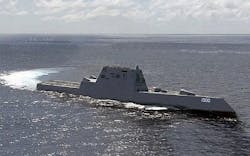Navy pours millions of dollars more into Zumwalt surface warships; is this really a good idea?
This shipbuilding program involves the Zumwalt-class destroyer (DDG 1000), a stealthily shaped surface vessel built around a long-range cannon that can attack targets ashore as far as 83 miles away. Although that sounds promising, top Navy leaders consider it to be only marginally useful, because they have scaled back the Zumwalt project from a planned 32 vessels to only three.
That's just three ships. The Navy, by contrast, has 61 Arleigh Burke-class destroyers in commission, and these ships are still being built.
What's the Navy going to do with three of these land-attack destroyers? Is that enough for any kind of meaningful war planning? I would submit the answer's probably no, yet on Monday the Navy announced a potential $490.2 million contract to Raytheon Co., the Zumwalt's mission systems integrator, for total ship activation and engineering services.
This is nearly half a billion dollars more for a questionable and half-hearted Navy shipbuilding program that already is costing taxpayers in the neighborhood of $22.5 billion for just three ships.
Granted, I can see the rationale for the Zumwalt class. From its inception, the new ship has been a test bed of sorts for technologies ranging from its revolutionary radar-evading shape, to its drive system, to its long-range cannon, called the Advanced Gun System.
Still, the program has reason skepticism. It's called a destroyer, yet it's anything but. Compared to a modern Navy Burke-class destroyer, the Zumwalt is a behemoth, about the size of a World War I battleship.
The Zumwalt is 600 feet long, nearly 81 feet wide, and displaces 14,800 tons, which makes this vessel larger than the Navy's Ticonderoga-class cruiser, WAY larger than the Burke-class destroyer, and only slightly smaller than the 1950s-vintage Navy nuclear-powered Long Beach-class cruiser.
The Zumwalt has a new kind of stealthy design to help reduce its radar signature. Still, any attempt to create a stealthy design just isn't going to conceal anything that big very effectively.
The Advanced Gun System might be a promising development, but it turns out its ammunition is too expensive to shoot. Last fall, just three weeks after the Zumwalt's commissioning, Navy leaders said they are canceling buys of the Zumwalt's expensive ammunition.
Related: Navy may replace Zumwalt destroyer gun ammunition with Raytheon smart artillery round
Instead, the Navy may end up using the Raytheon Excalibur smart artillery shell, developed for the U.S. Army, to fill the Zumwalt's ammunition needs.
Also last fall, the Zumwalt lost propulsion in the Panama Canal due to an engineering problem and had to be towed to port. Crew members aboard the ship reportedly saw water getting into bearings that connect electrical motors to drive shafts.
I'm not trying to be overly harsh; I realize that new weapons systems often have initial problems that need to get ironed out. Often these early problems aren't justifiable reasons to cancel big programs. The F-35 joint strike fighter is a prime example, and the F/A-18 Hornet strike fighter before that.
Yet I have to question pouring hundreds of millions dollars more into the Zumwalt program that will have just three ships -- and those three represent a best-case scenario. One of those ships, in fact, is still under construction, and yet could be scrapped before it's finished to save money.
The Trump Administration will be hard-pressed to increase the Pentagon's budget, as Trump has pledged to do, with a divided Congress. Is now the right time to be spending substantially more to support a naval ship program that isn't likely to have much influence on future warfighting plans?
Learn more: search the Aerospace & Defense Buyer's Guide for companies, new products, press releases, and videos
